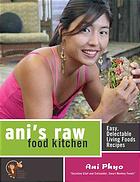Ani’s Raw Food Kitchen : Easy, Delectable Living Foods Recipes. / Ani Phyo. Marlowe and Company, N.Y. , 2007. 255 pages including 10-page index, illustrations in black and white and color.

Ani’s Raw Food Kitchen gets my top vote for a raw food lifestyle and un-cookbook because it offers nutritional advice and how to live a green lifestyle from a 100% raw food perspective. You don’t have to be a raw foodist to benefit from this book and its creative approach to making food fit for the gods.
However if you do love raw food, even occasionally, the recipe collection in this book will show you how easy it is to maintain a raw food kitchen. And raw food is not complicated—in fact it can be easy! The fruits, vegetables, oils, and herbs and spices the author highlights will bring maximum taste and superior nutrition to your table.
One of Ani’s admitted joys is to recreate memories of delectable cheese, fish or even vegan, egg-style breakfasts in taste-alike luscious living foods. Ani’s “icey kreams”, frozen confections, which are a combination of dates, nuts and coconut meat, are served with sweet sauces. Recipes for sweets, cakes, pies, sweet soups outnumber her recipes in other sections. “Mylks” are a versatile way of creating non-dairy milk for cereal, or in place of water in other drink recipes.
For unusual treats, there are bread or croutons for your main dishes or sandwiches, dips and sauces, un-tuna, pates and doughnut holes. Smoothies, shakes, salads, main dishes, and deserts represent the range of possibilities in a raw food diet. Yet, each recipe stands alone and could form the living food portion in your regular meals, and will be to the ‘enth power more healthful and delicious than cooked.
Unique features of Ani’s books are the nutritional information for most recipes and a comment on how long the food will last once prepared and refrigerated. For special instructions such as how to open a Thai baby coconut, see “Ani’s Kitchen Tips”. These pop-up inserts in each chapter reveal raw food kitchen secrets.
A personalized journal of environmental awareness and how we get our food accompanies the text. Her themed essays on living a clean and green-inspired life photographed by Ede Schweizer set the tone of each section, showing beach time, after a workout, local markets, and Ani’s pooch, a wonderful Rhodesian ridge-back named Kanga. Each of the eight sections of the book are prefaced with a rich array of the highlights of living the philosophy, with a generous helping of creativity that makes Ani’s recipes so popular with celebrities, at raw food events and on national television shows. Raw is news (in 2007 when the book came out, and beyond), and one of the most extreme diets of the times.
As Ani explains, your preference for green living is expressed by your purchase of local versus store-bought food. Supermarkets, in spite of being ubiquitous, handy and always open, represent quantity and lots of prepared, canned, and frozen products. They are provisioners of a huge range of merchandise that doesn’t resemble fresh and living in the least.
The author’s inset on page 23 lists seasonal produce and fruits. For spring, look for green, young and new, in leafy vegetables, fresh herbs like parsley and basil, and asparagus. (Navel oranges become ripe in spring in California and then are shipped around the country.) In summer, fruits that produce a cooling sensation are strawberries, tree fruits like pears, stone fruits, and berries and melons. Most of these are grown regionally. When fall arrives, apples and grapes, also regionally-grown fruits, carrots, onions and peppers will be freshest and locally available. In winter, root vegetables, squashes, leeks and turnips will be warming in recipes, along with the harvest of lemons, grapefruit, and other citrus from the warmer areas of the country.
Buying locally available and seasonal fruits and produce is all the more important when you consider the relatively small but important part your decisions make. Farmers’ markets depend on the local people’s interest; the active participation of its community solves the problem of getting fresh and seasonally available food. Buying local usually means seasonal good weather, luscious taste, and vital health!
Ani is emphatic about taking full advantage of bountiful farmers’ markets and local cooperatives over dependence on supermarket fare. Preferring raw, Ani makes the case for using fresh, locally grown fruits and vegetables and says that when we eat local, we can expect more taste and nutrients (in fruits and vegetables) from living foods. And menus following seasonally available fruits and vegetables will give you a rich assortment to choose from, year round.
Because Ani’s Raw Food Asian, has been a great place to select really unique and delicious Asian-style raw recipes, I’m inclined to see the recipes in Ani’s Raw Food Kitchen as a basic raw food pantry, daily comfort food that’s sometimes fancy, but not necessarily exotic. Because what we are really looking for in food is to be excited by the taste. Ani’s Raw Food Kitchen is a celebration of living foods from well-known, community sources for your table.
Follow


